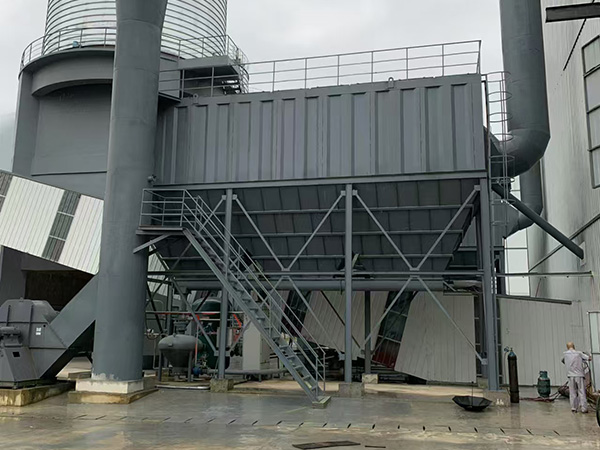-
All
-
bag Dust Collector
-
Electrostatic Precipitator
-
Cartridge Dust Collector
-
Desulfurization And Denitrification Equipment
-
Dust Collector Bag
-
Dust Collector Skeleton
-
Electromagnetic Pulse Valve
-
Rotary Valve
-
Screw Conveyor
-
Dust Conditioner
-
Plug Valve/Butterfly Valve
-
Scraper Conveyor
-
Catalytic Oxidizer
-
Cyclone Dust Collector
-
Sintered Plate Dust Collector
-
Spray Tower
-
Activated Carbon Adsorber
-
Light Oxygen Purifier
-
Dry Filter Box
-
Bucket Elevator

Pulse Bag Filter
Pulse bag filter is an industrial dust removal equipment that combines pulse jet dust cleaning technology with bag filtration advantages....
Pulse bag filter is an industrial dust removal equipment that combines pulse jet dust cleaning technology with bag filtration advantages. Its core advantages include good dust cleaning effect, long filter bag life, and wide adaptability to various scenarios. It is widely used in industries such as power, building materials, machinery, chemical industry, metallurgy, etc. It can handle dust containing gases with dust concentration of 50-3000g/m ³ and air volume of 2000-150000m ³/h, and has a filtration efficiency of over 90% for dust particles with a diameter of 0.3 μ m or more. It can meet the requirements of medium scale dust production control for small and medium-sized enterprises, as well as dust purification for large-scale production lines. It is the mainstream type of bag filter in the current market.
From the perspective of structural design, the core of the equipment consists of five parts: a filtering unit, a pulse ash cleaning system, an airflow distribution device, an ash hopper ash discharge component, and an intelligent control system. The overall design is optimized around "effective ash cleaning". The filtering unit is the foundation, with dozens to thousands of filter bags built into the box. The material of the filter bags is selected according to the working conditions: polyester fiber filter bags are selected for dry dust at room temperature, PPS or aramid filter bags are used for high temperature (≤ 280 ℃) scenarios, PTFE filter bags are selected for corrosive environments, and the filter bag length is 1.5-6m. It is fixed to the filter bag flower plate through spring expansion rings or clamps to confirm airtightness; The pulse dust cleaning system is the core, consisting of a gas storage tank, a pulse valve, a spray pipe, and a Venturi pipe. The spray pressure is 0.4-0.6MPa. Compressed air is accelerated by the spray pipe and Venturi pipe and sprayed into the filter bag at high speed, forming an instantaneous reverse airflow that allows the filter bag to expand and shake at a suitable speed, effectively removing dust. Compared with traditional vibration dust cleaning, the pulse spray force is more uniform and causes less damage to the filter bag. The airflow distribution device guides the dust containing gas evenly through the filter bag through the guide plate and porous distribution plate, avoiding local overload of the filter bag; The ash hopper adopts a conical design. Small and medium-sized models are equipped with manual butterfly valves or star shaped discharge valves, while large models are connected to screw conveyors and bucket elevators. Some high humidity conditions may also be equipped with heating or arch breaking devices to prevent dust condensation and blockage; Intelligent control systems often use PLC programming control, which can achieve timed cleaning or differential pressure cleaning (starting with resistance up to 1200-1800Pa), while real-time monitoring of equipment temperature, resistance, and pulse valve status, supporting fault alarm and remote control.
Its working principle follows the cycle of "filtration pulse cleaning ash discharge", with the core being the effectiveness of pulse spraying: dusty gas enters the equipment through the inlet, is dispersed by the airflow distribution device, passes through the outside of the filter bag, and the dust is trapped on the surface of the filter bag. The purified gas passes through the filter bag into the clean air chamber and is discharged through the outlet; When dust accumulates on the surface of the filter bag, causing an increase in equipment resistance, the PLC system triggers a pulse cleaning program. The compressed air in the air storage tank is timed and quantitatively sprayed into the blowing tube through the pulse valve, forming a high-speed airflow column through the Venturi tube and instantly rushing into the inside of the filter bag. The filter bag expands and contracts at a suitable speed under the action of the airflow, and the surface dust is forcibly stripped off and falls into the ash hopper below; After the accumulation of dust in the ash hopper reaches a certain amount, it is discharged through the ash discharge component, completing the entire dust removal cycle without the need for shutdown (online cleaning) or only single room offline (offline cleaning), protecting the continuous operation of the equipment.







